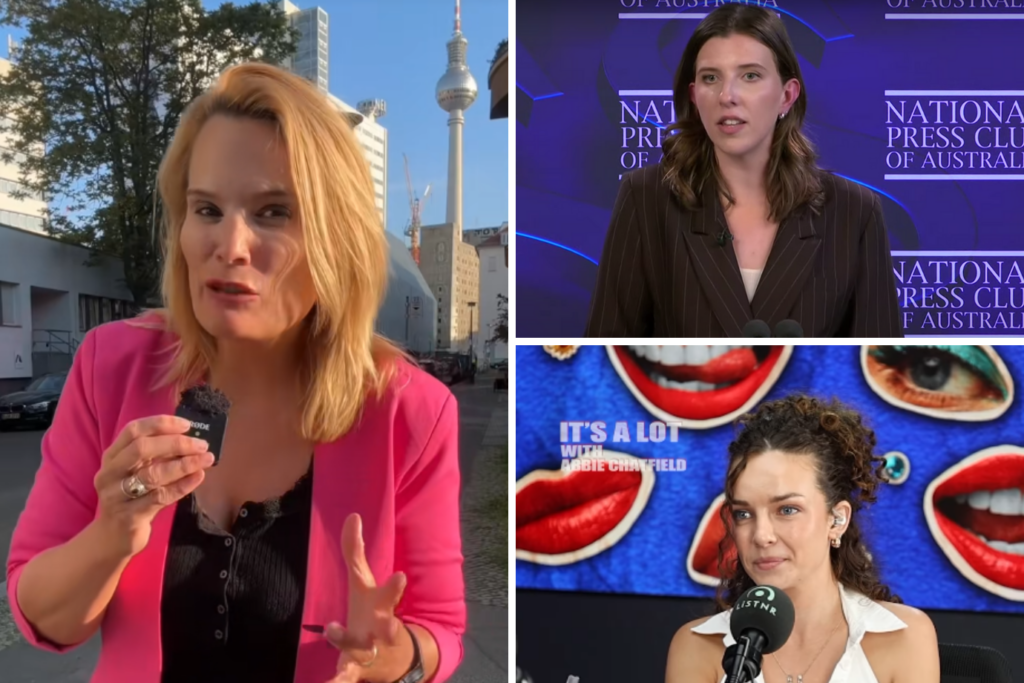Johanna Rüdiger was once flooded with questions from traditional journalists about dancing on Berlin Fresh, German broadcaster DW’s first TikTok account. But five years since Rüdiger started combining her social media strategy day job with running the account, amassing a staggering half a million followers, she receives “less and less” queries.
As the content creator, who provides news updates in English about crucial issues in Germany and featured the country’s recent elections, told April’s International Journalism Festival (IJF) in Perugia, Italy: “It’s a fun way to inform people. I get messages from people saying ‘you’re my main news source.’”
With one quarter of Australians now depending on social media as their main news source, according to University of Canberra research, it’s no wonder that “newsfluencers” as they’ve been dubbed by some, was one of the main themes of this year’s annual IJF. At least four panels at Europe’s largest media event were devoted to this trend.
One was called All journalists are content creators: it’s time for us to embrace that. It featured former award-winning CNN foreign correspondent Jane Ferguson, who is behind a new app Noosphere to help content creators access the market. She told the audience: “I mourn the death of legacy media organisations…but the business model is not working.”
Ferguson’s not the only one who’s turned to this space. In another IJF session Sophia Smith Galer, a BBC and VICE journalist who has developed a chatbot to help journalists create viral video scripts, said it was such an “over-saturated” area today that she competes with news publishers, other influencers, and journalists.
And another panel at IJF, Europe’s largest media event, was titled “Being a ‘one woman show” in media: what you need to know. A 2024 Pew Research Center study found that 63 per cent of “newsfluencers” were men compared to just 30 per cent of women. This gap though was smaller on TikTok, where half of the news influencers were male and 45 per cent were women.
The Australian Broadcasting Corporation (ABC’s) own content creators program was singled out in another IJF session by the UN’s Educational, Scientific and Cultural Organization agency (UNESCO). UNESCO has been working with digital content creators in a bid to understand their motivations, practices, and challenges.
The audience in Italy was told how last year the ABC Innovation Lab merged five TikTokers, YouTubers and Instagrammers with newsroom journalists. It created an initiative which staggeringly attracted over 62 million views, predominantly aged under 35. The ABC, who told Women’s Agenda that they’re continuing the program, described it as groundbreaking.
But in Australia, mixing content creators with legacy media has attracted some sneeriness from certain sections of the latter. In February Abbie Chatfield, the Sydney-based self-described “reality TV queen, entrepreneur and chronic over-sharer” with 550k Instagram followers, interviewed Prime Minister Anthony Albanese. She was accused, among other things, of being a “loose podcaster” conducting a “soft interview” and later cleared by the Australian Electoral Commission (AEC) of breaching electoral laws after a review of social media posts.
In March, dozens of creators were invited to be part of the Australian federal budget lockup and interview senior ministers. They included Milly Bannister, an award-winning founder of a youth mental health charity and creative director, who was dismissed as an “influencer in activewear”. Speaking about some of the backlash to Women’s Agenda, she said that she deeply valued journalism and had both studied and worked in it. “(But) we’re not here to undermine journalism,” Bannister said. “We’re responding to a trust gap that already exists, and using different tools to meet young audiences where they are.”
The new guard also present at Parliament House included chief executive officer (CEO) of Cheek Media Co Hannah Ferguson, who said that there needed to be regulation of paid political content on social media in Australia, when she addressed the National Press Club on May 14. She added that “influencer” had been the “dirtiest word” of the country’s election campaign, used to dismiss young women.
According to the United Nations Educational, Scientific and Cultural Organization (UNESCO), two thirds of the content creators they spoke to in 2024 were not fact checking before sharing information – but 73 per cent wanted to be trained to do so. It led to the organisation producing a free online course with the Knight Center for Journalism in the Americas offering practical skills in fact-checking and ethical communication.
Other creators have taken things into their own hands. V Spehar, a nonbinary TikTok news pioneer who was the original host of the LA Times TikTok account and also worked for The Washington Post, told an IJF audience they had asked for 20 hours of mentorship per month from one employer. Spehar then taught colleagues how to file Freedom of Information (FOI) requests, and about security, media liability, and insurance. They stressed that if they missed a fact, they would get “absolutely lambasted “ by audiences, who Spehar said had themselves become fact checkers in a way.
In a media landscape now dominated by tech bros, oligarchy billionaires and in some parts of the world authoritarian governments, Spehar also questioned whether influencers were the real enemy of journalists and if there were bigger battles. “I think when we start to realise that we have more in common and that we are actually not the competitors – it is us versus the oppression – then we start to find that camaraderie and that fun part,” they said.
It was a point underscored by UNESCO, who have noted that according to 2024 data on the digital safety of content creators in Indonesia, digital attacks pose serious threats to the physical and emotional security and privacy of these media professionals, which led to loss of income.
Josephine Karianjahi, co-founder and co-director of the women-led, Kenya-based podcasting company Africa Podfest, also told IJF that when they launched, podcasters in Tanzania had been required to obtain a license to work there.
Summer Harlow, an associate director at the Knight Center for Journalism in the Americas, told Women’s Agenda that there was no “one-size-fits all” content creator model. But she stressed that these new media professionals were open to experimenting, which is what traditional journalists needed to consider.
Harlow stressed though that influencers needed to be aware of “ethics—of transparency, of dis- and misinformation, of fact-checking, and everything else that goes along with producing accurate and fair news and information”. She said: “I don’t think that means creators need to be ‘objective’ and commit the same mistakes of false balance that traditional journalists made in the name of objectivity. But they do have to commit to professional and ethical standards of truthtelling.”
Nor were news creators going to replace journalists, said Harlow. “But I do think audiences will be better served if their news diets include a mix of all the different kinds of news and news producers out there,” she said. This needed to come with a caveat that not all creators are generating news and information, and that “not everything that purports to be news is truthful, since a lot of it is just pure propaganda”.
In Australia Bannister, who said that if anything her experience covering the budget had made her “a million times more committed” to bridging the gap between policy and the young people as part of new media, thinks that the debate is already shifting.
“(Young people) can scroll past a TikTok explainer and still value investigative reporting,” she said. “They’re learning to cross-reference, to follow up a creator’s post with a deeper dive or fact check from a trusted outlet.” The real shift though wasn’t in how they produced content, but in how audiences were becoming more active participants in the very media they consumed.
Meanwhile Rüdiger said that at this year’s IJF so many people had approached her about wanting to leave their jobs to “become a newsroom” and build their own brand. “So I think it’s time that legacy media and traditional journalists recognise the value of news content creators and news friends or news communications, however we want to call them, and work together,” she said.


